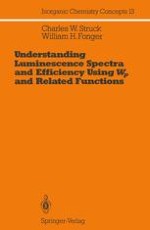There are both a remote and a proximate history in the development of this book. We would like to acknowledge first the perceptiveness of the technical administrators at RCA Laboratories, Inc. during the 1970s, and in particular Dr. P. N. Yocom. Buoyed up by the financial importance of yttrium oxysulfide: europium as the red phosphor of color television tubes, they allowed us almost a decade of close cooperation aimed at understanding the performance of this phosphor. It is significant that we shared an approach to research in an industrial laboratory which allowed us to avoid the lure of "first-principles" approaches (which would have been severely premature) and freed us to formulate and to study the important issues directly. We searched for a semiquantitative understanding of the properties observed in luminescence, i. e. , where energy absorption occurs, where emission occurs, and with what efficiency this conversion process takes place. We were aware that the nonradi ative transition rates found in practice vary enormously with temperature and, for a given activator, with small changes in its environment. We traced the source of this enormous variation to the magnitude of the vibrational overlap integrals, which have strong dependences on the rearrangements occurring during optical transitions and on the vibrational number of the initial electronic state. We were willing to excise from the problem the electronic aspects - the electronic wavefunctions' and their transition integrals -by treating them as parameters to be obtained from the experimental data.
